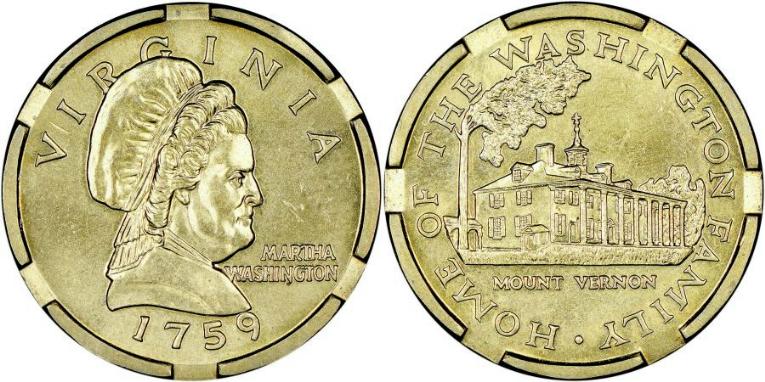

 The following metallurgical trial piece was struck in 1999. It uses the Martha Washington design first used in 1965 on J2101/P2081, J2116/P2082 and J2134/P2083 from the second set of dies to test the golden colored manganese brass coated planchets which would later be used for the Sacagawea dollar. Photo courtesy of Douglas Mudd of the National Numismatic Collection of the Smithsonian Institution. This design has become the U.S. Mint's all-purpose design for testing new compositions and planchet sizes both inside the Mint and outside by companies contracted by the Mint including IDX Inc, PMX Industries, Schuler AG and Olin Brass Corporation. Until a few years ago, only a few people outside the Mint itself were aware of the existence of these trial pieces when the one at the top of this web page was first imaged, but not retained, by the Smithsonian. The following, regarding these pieces, is excerpted from an article in the July 16, 2001 edition of Coin World. "The U.S. Mint spent millions of dollars in research and development of an alloy for the Sacagawea dollar, with IDX Inc. being one of the firms contracted to test prototypes in their coin acceptors. James Halsey, president of IDX Inc., said numerous samples in different alloys bearing the Martha Washington obverse and Mount Vernon reverse dies - special designs used for experimental coinage - were shipped to IDX for testing. Some of the packages were insured for as high as $250,000, with the recipients required to return any and all pieces supplied by the Mint for the tests." According to a Coin World article in the June 24, 2002 issue, "anti-tarnish tests were conducted at the Philadelphia Mint on January 8, 2000, on Sacagawea dollar blanks struck with the experimental Martha Washington obverse, Mount Vernon reverse experimental dies, according to Mint e-mails." The Coin World article continued: "Seven processes were explored: one on circulation quality strikes, three on Uncirculated [Mint set] quality coins, and three on Proof quality strikes. The coins were struck on at least four different kinds of presses, with the blanks subjected to one of five burnishing methods." The ANR piece pictured above is one of at least 2 confirmed examples which may have been struck to test one of those burnishing methods as its surfaces are more matte-like in appearance than the Smithsonian or Heritage 11/03 sale piece which have a brilliant finish and is illustrated below and is shown courtesy of Mike Byers. All of the above examples having a plain edge are listed as J2185 if they have manganese as part of the composition. As of 2017, over 100 are known in uncirculated business strike format and at least a half dozen are known in proof format. The Mint also appears to have performed several experiments for the blind including J2185A which has 6 notches on the border as illustrated below courtesy of NGC which just sent us this example in July 2019. The piece was subsequently offered in Heritage's October 2019 sale. A second piece appeared in Heritage April 2020 sale.  and also J2186 which has an intermittently reeded edge - 5 or 6 reeds per block - as shown below. An example with this edge device example was offered in Superior's 11/08 sale. Another example J2187 has a fully reeded edge and was offered in the Bowers and Merena 2006 ANA sale. This would have made the dollar coin too similar to a quarter and was almost certainly rejected for that reason. Pieces are also known struck from a non-manganese alloy and have the letter N dotted on both sides of the obverse as shown below. We are calling these J2188. According to the Heritage sale which first offered one, an accompanying letter from the Department of the Treasury explains the new disks that carried no actual denomination: "The Purpose of these prototype alloy samples is to field test two (2) alloy systems that the Mint has prepared for the new dollar coin. We need to get feedback from the industry relative to any tokens, foreign coins, or any other materials that may result in slugging problems. (In other words, these samples should not be accepted in any of your current electronic coinage discrimination channels.)" The Heritage example has a plain edge, and was found to be 77% copper, 20% zinc and 3% nickel. The sale also included an example which was 1% manganese which did not have any letters dotted in the field which we would list as a J2185. It is not known if all examples with the 'N's on them lack manganese or not. As of 2017, about 50 are known with the 'N's. There are also several examples known in the above alloy without the dotted Ns J2189. A cupro-nickel clad Martha Washington pattern dollar with the intermitent edge device is also known and is now listed as J2184. For more on this piece, click here. Photo courtesy of Saul Teichman. |